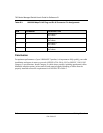
700 Series Managed Switch User’s Guide for Software v2.1
2 Glossary
SM-10004-02
also Reverse ARP (RARP) which can be used by a host to discover its IP address. In this case, the host
broadcasts its physical address and a RARP server replies with the host's IP address.
Auto-negotiation
A feature that allows twisted-pair ports to advertise their capabilities for speed, duplex and flow control.
When connected to a port that also supports auto-negotiation, the link can automatically configure itself to
the optimum setup.
Auto Uplink
Auto Uplink
TM
technology (also called MDI/MDIX) eliminates the need to worry about crossover vs.
straight-through Ethernet cables. Auto Uplink
TM
will accommodate either type of cable to make the right
connection.
Backbone
The part of a network used as a primary path for transporting traffic between network segments.
Bandwidth
The information capacity, measured in bits per second, that a channel could transmit. Bandwidth examples
include 10 Mbps for Ethernet, 100 Mbps for Fast Ethernet, and 1000 Mbps (I Gbps) for Gigabit Ethernet.
Baud
The signaling rate of a line, that is, the number of transitions (voltage or frequency changes) made per
second. Also known as line speed.
Broadcast
A packet sent to all devices on a network.
Broadcast storm
Multiple simultaneous broadcasts that typically absorb all the available network bandwidth and can cause a
network to fail. Broadcast storms can be due to faulty network devices or network loops.
CA
A Certificate Authority is a trusted third-party organization or company that issues digital certificates used
to create digital signatures and public-private key pairs.
Cat 5
Category 5 unshielded twisted pair (UTP) cabling. An Ethernet network operating at 10 Mbits/second
(10BASE-T) will often tolerate low quality cables, but at 100 Mbits/second (10BASE-Tx) the cable must be
rated as Category 5, or Cat 5 or Cat V, by the Electronic Industry Association (EIA).
This rating will be printed on the cable jacket. Cat 5 cable contains eight conductors, arranged in four
twisted pairs, and terminated with an RJ45 type connector. In addition, there are restrictions on maximum
cable length for both 10 and 100 Mbits/second networks.


















